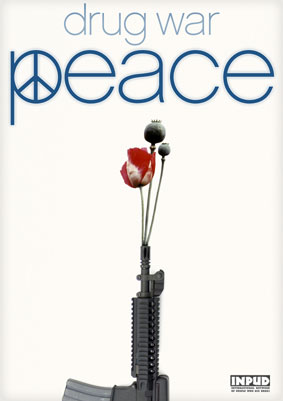| By Tom Geoghegan BBC News Online |
Erin O'Mara is a bright, bubbly magazine editor - hardly the stereotype of someone who injects heroin four times a day. 
But her habit, now in its 20th year, does not line the pockets of a drug dealer. The 34-year-old gets her fix from her local chemist in west London. This "perfect prescription", as she calls it, began two years ago and rescued her from a life of prostitution, drug dealing and serious illness.
The downward spiral began with Erin's first taste of heroin aged 15 while in her native Australia, and has included 10 unsuccessful methadone programmes along the way.
To finance her habit, she began working as a masseuse, which led to escort work and then street prostitution. That stopped when she discovered she was HIV positive.
But the prescription has transformed her life. As founder of Black Poppy, a magazine by and for drug users, she addresses drug conferences and is being consulted about pilot projects.
Sitting in her office, she says: "My prescription has meant I have money now, and choices I can make in my life - simple things like what I want for dinner. I can do things I haven't done for years and can think five years ahead. Before I was just thinking about my next 'hit'."
Each shot supplied by her chemist is just enough to enable Erin to function properly and prevent the onset of withdrawal. She only feels the buzz if she relaxes. ![]()

The NHS allows only licensed doctors to prescribe diamorphine, the medical name for heroin, to addicts if they have failed to respond to methadone treatment. At present just 0.5% of those in treatment are prescribed heroin, but new pilot projects are expected to increase that number.
Supporters of this policy, such as the independent research group DrugScope, say controlled distribution by the state can drastically reduce crime.
They also argue that clean heroin like diamorphine is not in itself dangerous, just incredibly addictive. And a pharmaceutical prescription excludes all the risks associated with unsafe injecting and enables the user to gradually be weaned off the drug.
Topped up doses
Erin believes this approach can save lives. But prescribing heroin is not always the answer, as she herself knows from the first programme she took part in in 1998.
"The whole set-up was really oppressive and heavy-handed, but the doses were too low so people were using other drugs and too scared to admit it. No-one was happy and no-one was doing well on it. The carrot and stick approach doesn't work because you can't punish users enough to make them stop". ![]()
![]()
One patient, a 45-year-old woman, threw herself off a tower block two days after being penalised by having her prescription withdrawn, Erin says.
And with strict attendance requirements and supervised injections, it prevented users from getting full-time employment.
Erin claims she was forced off the course after 18 months when she tried to start a support group. She then founded Black Poppy to give a voice to drug users, and address issues missed by treatment programmes.
After leaving the prescription programme, Erin was put on methadone injections, which she topped up with crack. This period was one of her lowest and her veins began to collapse. ![]()

![]() Why did I have to wait until I'd finished selling my young body to men?
Why did I have to wait until I'd finished selling my young body to men? ![]()
When she heard about a vacancy on a pioneering prescription course at the Maudsley Hospital in south London, she cornered the doctor in charge at a drugs conference.
"I remember my sense of complete and total desperation. I felt I could not go on any longer, that if they didn't help me, I didn't know where I would be. I felt that this was my last hope, that I'd tried everything. And I begged."
Her powers of persuasion paid off and she joined what turned out to be a more flexible programme. She was able, for instance, to spend a few months at her mother's in Colchester and pick up her prescription from a local chemist, so long as she visited the doctor every fortnight.
Her immune system strengthened, and two years on she is on a reduced dosage and aims to come off heroin completely.
As she looks to the future, there is a trace of anger about the years spent on and off treatment programmes. ![]()
"Why did I have to wait until I'd finished selling my young body to men, until I'd got sick and deeply depressed, until I'd used every vein in my body from my neck to my feet, until I'd contracted both HIV and Hep C?"
But she is optimistic that the government has begun to move in the right direction and listen to what drug users want.




